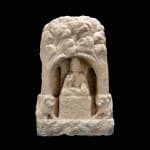Ming Buddhist Shrine, 1368 CE - 1644 CE
Stone
47 x 28.6 cm
18 1/2 x 11 1/4 in
18 1/2 x 11 1/4 in
AM.0340
Further images
This remarkable object has been carved on all four sides. Two sides feature a seated Buddha, alternated with standing bodhisattvas, each holding a lotus bud and a heart-shaped fan. The...
This remarkable object has been carved on all four sides. Two sides feature a seated Buddha, alternated with standing bodhisattvas, each holding a lotus bud and a heart-shaped fan. The Buddhas hold their right hand up in a gesture of reassurance or blessing. The tree which forms a canopy represents the Bodhi Tree. This was the site where the historical Buddha, Siddhartha Gautama, achieved Enlightenment in the sixth century BC. The four corners of the sculpture are defined by four tree trunks, incised with rippling lines. Eight lions crouch beneath the four trunks. The religious significance of the lion has a long history in Buddhism. In early Buddhist art the Buddha was not portrayed in human form but represented by a number of symbols. These included an eight-spoked wheel, the Bodhi tree, and- most significantly for our purposes- a lion. Lions were traditionally associated with regality, strength and power and this relates to the historical Buddha's former life as a royal prince. The Buddha's teachings are also sometimes referred to as the 'Lion's Roar'. This unusual object may well have been used in a private devotional setting, as a tool for meditating on the Buddha's Enlightenment. As a physical expression of piety and wealth during the Ming era, this is a fascinating piece.













